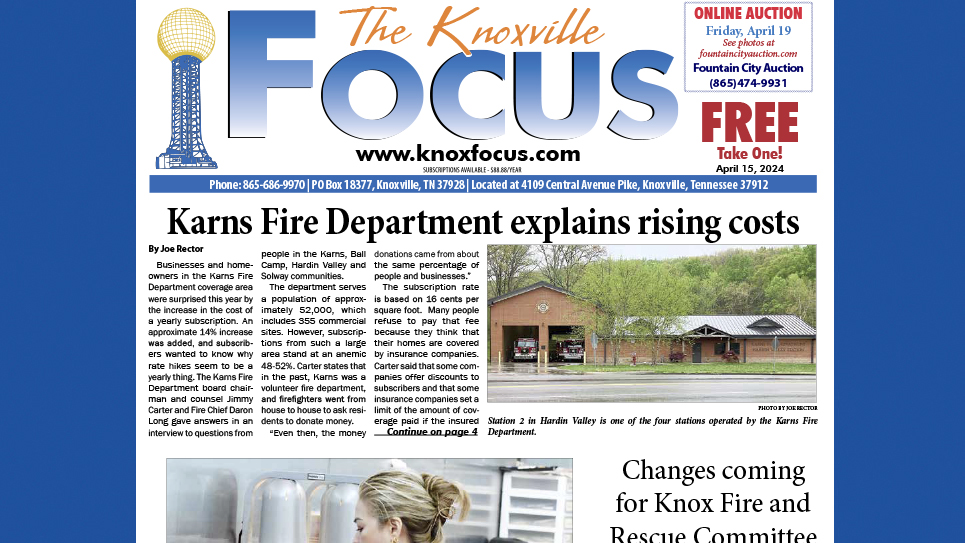By Dr. Jim Ferguson
I’m tired of thinking about the coronavirus crisis, though it is difficult not to be in its clutches. Becky’s mother just celebrated her 103rd birthday and Becky organized family and friends to parade by our matriarch within their cars because of social distancing! It was a unique celebration. So much so that WBIR put it on the nightly news.
This time of year, I often think of the opening line of a Robert Frost poem I love, “Nature’s first green is gold…” You must Google the poem and savor Frost’s sublime reflections on springtime’s unique color of green.
Lately, I’ve been thinking about other colors of spring. The redbuds – a curious name – are stunning this year. I always welcome their splash of purple heralding the end of winter, even when we are sometimes challenged with brief “redbud winters.” And have you noticed that this spring’s wisteria has been, as David Keith might say, “bodacious”?
I love purple wisteria, but recently I saw the white variety in several places, as well as lavender. There is also a pink variety, but I have not seen it. Recently, I learned we have something in common with China other than its viruses. Apparently, wisteria is native to the Eastern United States and China, as well as Korea and Japan.
Most of us learned the color spectrum with the acronym ROYGBIV (red, orange, yellow, green, blue, indigo, violet). Purple is the major color that occurs least frequently in nature (Wikipedia). Perhaps this is why purple has historically been associated with royalty, mystery and piety. Tyrian purple was coveted in the Roman era and obtained from tiny snails harvested along the coast of the Eastern Mediterranean in the region of Tyre (current day Lebanon).
It is Maundy Thursday as I write this essay and, recently I became curious about the term Maundy Thursday of the Easter celebration.
Maundy derives from the Latin word mandatum which is a command. Jesus met with his Disciples for a Last Meal the night before his crucifixion. His command was to eat and drink “in remembrance of me” (Luke 22:19). This last meal has become the principle sacrament of Christ’s followers, a sign of God’s Grace.
Apparently, I’m still in the clutches of Latin, a “dead language which almost killed me.” My 4th grade Latin teacher angrily moved my desk to the back of the classroom and “insisted” I just keep quiet. I finally grew up and learned the benefits of Latin and Greek in college etymology courses. These studies helped me learn the “new language” of science in medical school.
It so happens that this year’s Jewish Passover, based on the lunar calendar, coincides with the Christian Easter celebration, based on the Gregorian solar calendar. As a result, these sacred celebrations don’t always happen together even though the cultures are intricately related. Western Civilization arose from Judeo-Christian heritage and culture.
We have a unique sign of spring this year: face masks. There is even a cottage industry making bandanna-like facial coverings in the hope of avoiding the coronavirus. After the 9-11 attack, I was fitted with a N95 mask during the anthrax scare. I’m not a PPE (personal prevention equipment) expert, but this uncomfortable mask was thought to offer some protection for doctors in the ER and the hospital. However, I had no misconception that the mask was a panacea. Thankfully, my mask was not put to the anthrax test.
“Come now, let us reason together,” said the Lord (Isaiah 1:18). Let me pose a question to the logic of my readers: Why does a surgeon wear a surgical mask during an operation? The answer is to protect the patient in case the surgeon sneezes or coughs. Similarly, if you are sick, coughing or sneezing you threaten others and a mask may be helpful to those around you. A mask might offer you some protection if it keeps you from touching your face with contaminated hands. However, masks, scarfs or bandannas are no substitute for common sense and I’m afraid masks are becoming more virtue-signaling than protective.
Sometimes in a crisis you have to look for the good. In our season of crisis, I see blossoms of kindness springing from social connections on the Internet. I see people posting on Facebook and Instagram (I avoid the sewer of Twitter). Emails fly around the country and the world offering connection, opinions, encouragement, music and even humor. Sometimes you need to laugh instead of crying-out in anger at fake news and Congressional reprobates. I’ve even been invited to a Zoom happy-hour. I plan to show up in cyberspace with a six pack of Corona beers!
I have a friend who is a master of the old-fashioned art of letter writing and uses stamps and “snail-mail.” I used to write notes to people, but my penmanship has deteriorated. (Being a doctor, my penmanship was never very good, though it was legible.) I marvel at the beautiful letters that John and Abigail Adams wrote to each other. Paper was very expensive then, there were no lines to keep the script level and there was no spell-check.
However, any phone call, electronic email or text message is better than no communication at all, and is so easy. And now we have the additional platforms of Skype, FaceTime and Zoom to connect us. I have observed that we are remembering each other more these days just as Christ commanded us to remember him. So, I believe the good in this crisis is the opportunity to connect with others. We also have more time for family and reflection. As citizens we are doing our part in the war against coronavirus. Use the time and the Internet to connect!
Robert Frost concluded his poem with, “nothing gold can stay.” The ancient Greek Heraclitus observed that everything changes, but he was speaking of earthly matters.
The Easter message is that the purple robe of salvation is timeless. It is a message of hope for our soul, our essence, to someday be welcomed home into another level of connection where we will finally hear, “Well done, good and faithful servant.” (Matthew 25:23)






